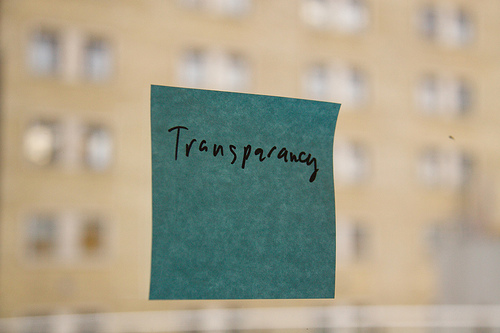 There is a natural human tendency to want to not look bad in the eyes of others. This tendency, driven by our prehistoric lizard brains, makes it difficult to admit we made a mistake or something is going wrong. A whole industry of “spin doctors” has sprung up to help you. They won’t help you admit you made a mistake, but instead will help you spin a tale of how it’s someone else’s fault. How about a new approach? Try telling the truth.
There is a natural human tendency to want to not look bad in the eyes of others. This tendency, driven by our prehistoric lizard brains, makes it difficult to admit we made a mistake or something is going wrong. A whole industry of “spin doctors” has sprung up to help you. They won’t help you admit you made a mistake, but instead will help you spin a tale of how it’s someone else’s fault. How about a new approach? Try telling the truth.
How transparency looks
Last week in “Do Twitter nice guys finish last?” I wrote about how Pavle Milic admitted he made a mistake by not recording our dinner reservation that had been arranged on Twitter. He told the truth, apologized and did all he could to resolve the problem. As long as mistakes aren’t the norm, I’m inclined to evaluate those I do business with based upon what they do when there are problems vs. when everything is going wonderfully.
Pavle could have done what my cable company does when I call. He could’ve blamed the problem on everything except what really happened – he made a mistake. With one phone call the next morning, Pavle and I reached an understanding that resulted in a satisfactory conclusion to the issue. I can’t solve a problem with my cable company with any fewer than a half dozen calls and seldom is the outcome satisfactory. It’s just an outcome that I eventually accepted because I was tired of spending time on the phone trying to make it better than mediocre.
Thank you: That’s another way transparency can look. In my ColorMetrix life this past week, we encountered a pretty nasty bug related to leap year. For two days, a big development project was on hold and one of our customers was down and unable to use our product, which has become an important part of his workflow. The bug did not originate in our code, but that doesn’t make it any less our bug in the eyes of our customers.
We owned the bug from day one and said we’d get it fixed as quickly as we could. We let the customer of the development project know his work would be delayed while we fixed this bug. We kept everyone involved informed with regular updates. We never blamed the manufacturer of our software compiler. We just found another way to do the date math that needed to be done.
How transparency feels
Transparency involves telling the truth and that’s what makes it feel good. You don’t need spin doctors to help you remember who you told what and why. Transparency saves time because you don’t need to hold a meeting to figure out what the official story is going to be. The official story is always the same thing: the truth.
Here’s my one caution: Transparency does not equal full disclosure. There are two reasons for this. 1) Your customers probably don’t want all the technical details of why you have a problem. They just want it fixed. 2) Confidential business information is still confidential. If there is a legal or competitive reason you can’t revel something, then you still can’t revel it just to be transparent.
What do you think? Should you tell the truth or spin it to save face?
Did you have to pick an image for this post that has a misspelling?